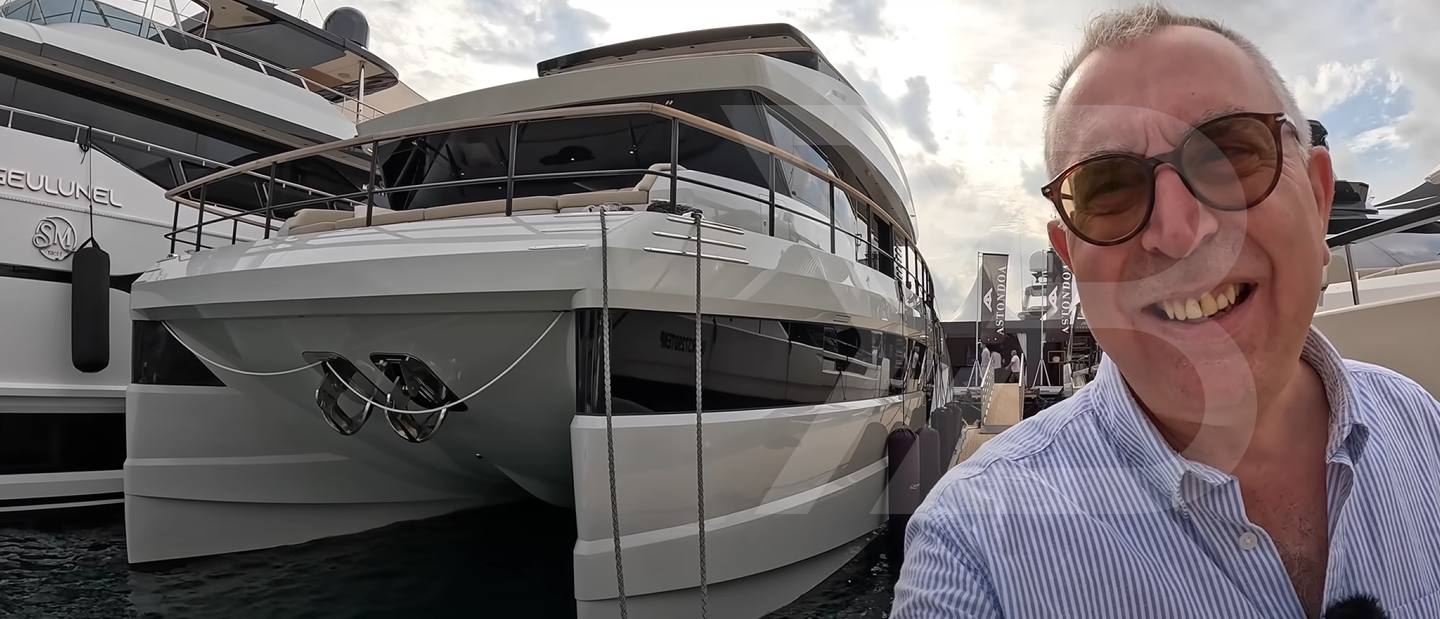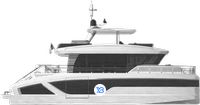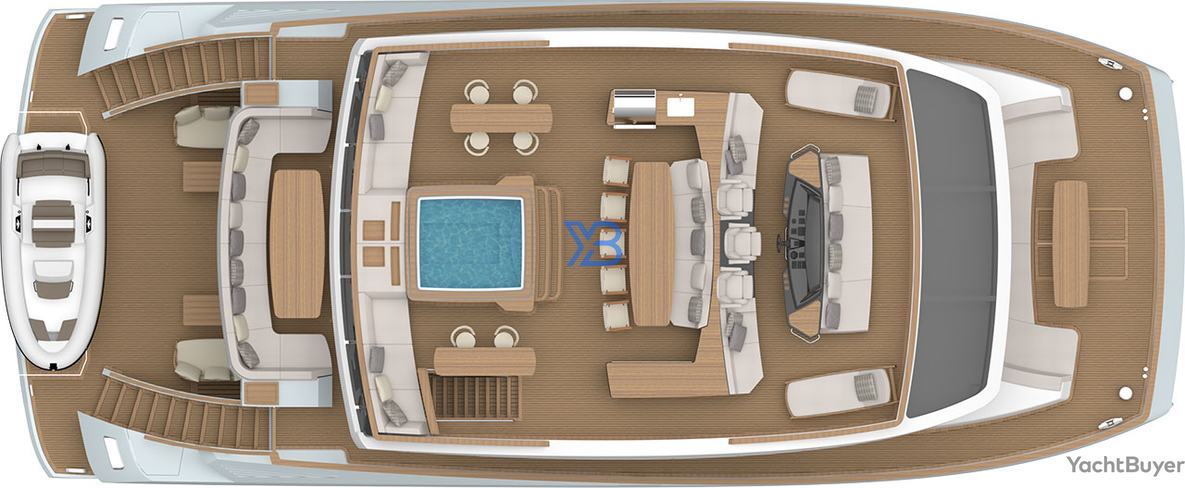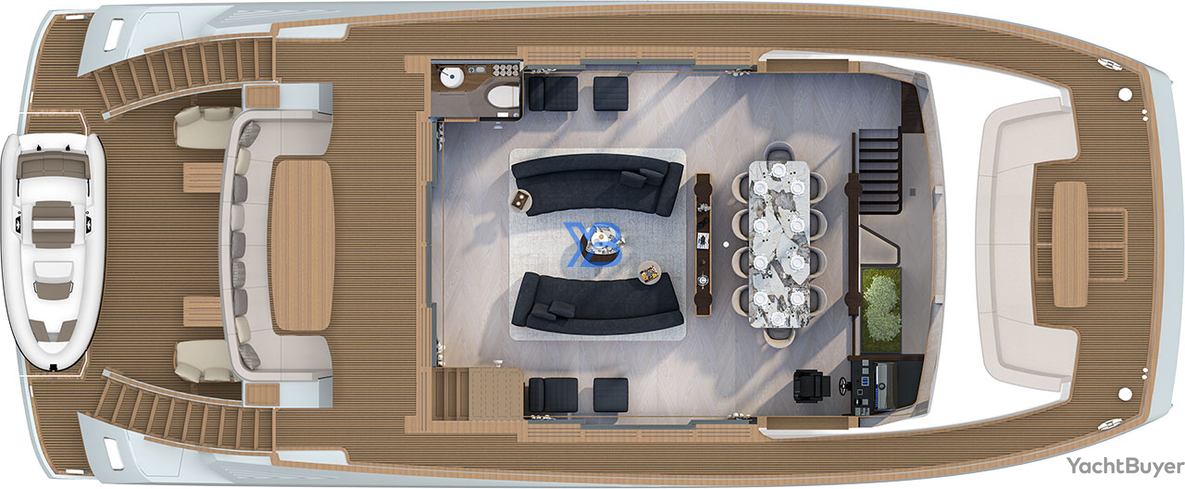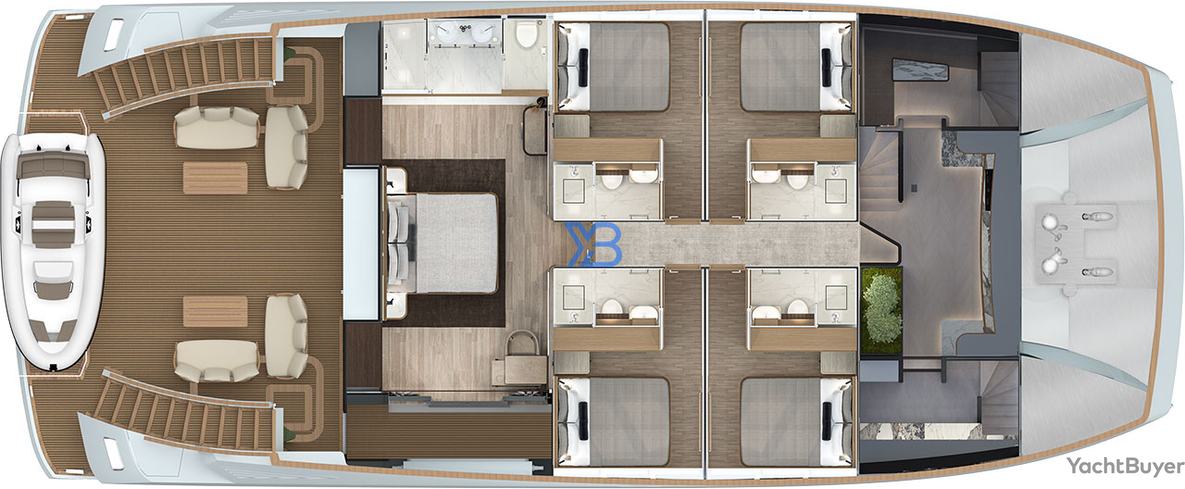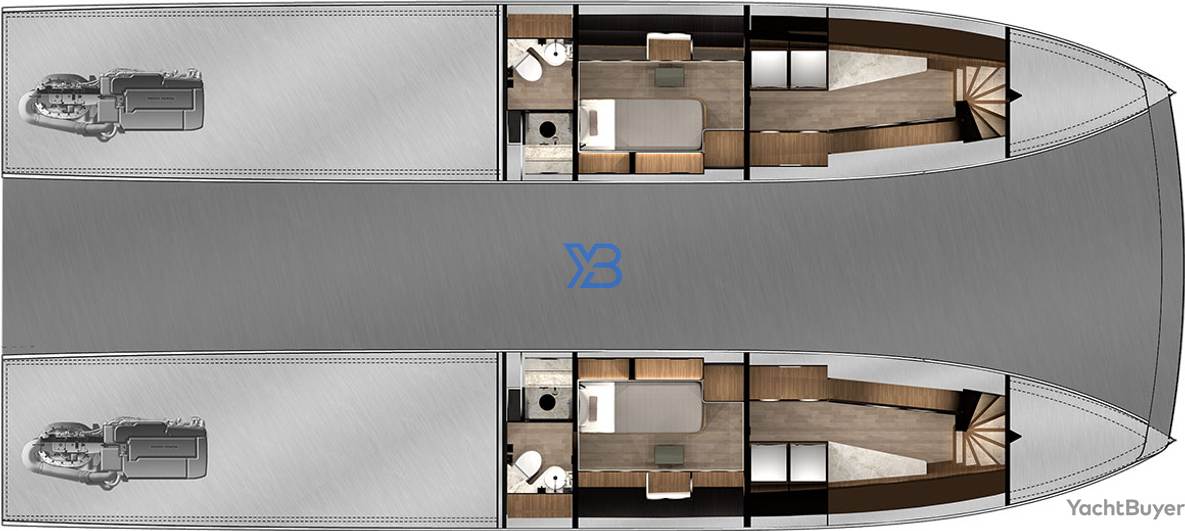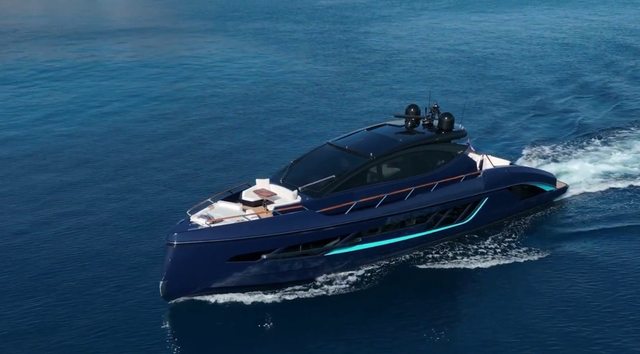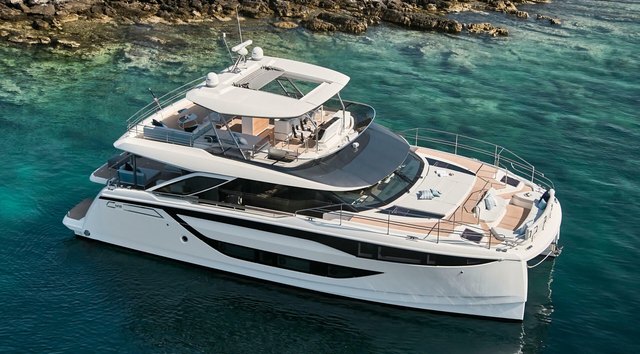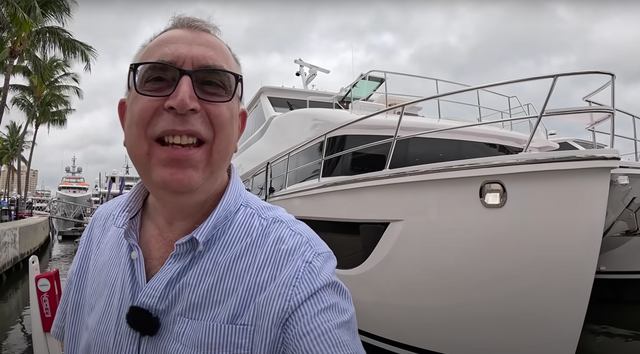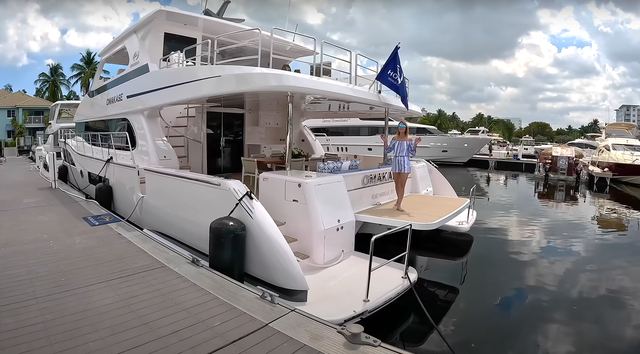Video Tour
On Deck
The Lazzara LPC 300 is something quite special. Hull number one, and the first of its kind, it measures just over 21m (71 ft) in length with a beam of 9m (29.5ft). That extraordinary width is what gives it 300sq/m (3,230 sq/ft) of living space. To put that into perspective, an 8m (26ft) boat could sit across the stern without touching either side. The scale of it is astonishing.
A hydraulic passerelle extends from the bathing platform and can angle up to a quay or down into the water for swimming. It retracts completely when not in use, keeping the stern clear. A lift section in the platform allows a tender to be brought aboard and raised level with the deck. The beach club spreads right across the transom, open and flexible in layout. All the furniture is freestanding, so the owner can set it up for dining, lounging or even fitness gear. It’s a generous, adaptable space that feels as though it belongs to a far larger yacht.
The aft glazing opens 4m (13ft) wide and 3m (9.8ft) high, with no threshold or lip, just a flush join between teak and interior flooring. Subtle drains across the sill manage any spray. When the doors are open, the main deck becomes one continuous living area, linking the beach club to the saloon in a single sweep.
The upper deck carries the same level of finish and thought. All the furniture including the large dining table and twin bar stations, is built in-house by Lazzara. One bar conceals an ice-maker and fridge, the other a sink, barbecue and locker storage. Forward sits the secondary helm with twin Garmin displays, joystick and throttle controls, and bow thruster. The view across the foredeck is completely open, the whole driving position feeling calm and measured.
Aft of the helm, a circular dining table sits under the canopy, followed by a curved seating area wrapped around a deep-set hot tub. In the corner, a private seat provides a quieter spot out of the main flow. Life-raft canisters line the aft rail, three in total, and above them the hardtop carries the satellite domes, radar, antennas and navigation lights.
At the bow, the wide foredeck becomes a social deck in its own right. The raised sunbeds rest on height-adjustable tables that lift for dining or drop for lounging. Stainless-steel rails and recessed lighting run the length of the walkways, guiding the way forward at night. Standing there, surrounded by open deck and sea air, the scale and finish feel remarkable for a 21m (71ft) catamaran. The exterior design has a rhythm to it – long, smooth lines, rounded edges, nothing abrupt.
Interior Accommodation
The exterior beam carries right through the saloon, giving a footprint more like a 30m (98ft) yacht. Every line, surface and join has a softness to it. There are almost no sharp corners, just long, gentle curves that flow through the cabinetry and bulkheads. The furniture is built in-house, shaped to fit the architecture rather than added after the fact, and the result is a space that feels calm and cohesive.
Floor-to-ceiling glass surrounds the main saloon, and the sections beside the seating slide open, allowing air to move cleanly through the deck. The freestanding furniture lets an owner decide how to use the space – formal dining, relaxed lounge or a mix of both. Lighting is layered and discreet, with warm LED strips tracing the edges of the joinery. There’s also a hi-lo television built into the cabinetry for movie nights.
To starboard, a day head is neatly concealed behind a curved door. Every detail, from the basin fittings to the grain of the wood, has been chosen to match the rest of the interior. Across the deck, the lower helm sits forward on the port side, equipped with Garmin navigation screens, joystick and throttle control, and the Boning monitoring system that manages every onboard function. It’s designed more for occasional use, but the position gives an excellent view forward and out through the side glazing.
The galley sits on the lower deck and is, by any measure, a professional-grade workspace. It spans the full beam of the centre section, giving a sense of height and openness that’s unusual on a catamaran. The overhead glazing draws light from the saloon above, so the space feels bright even when you’re working below, and the fit-out is all Miele with a full-size oven, induction hob, extractor, dishwasher, and extensive refrigeration including a tall fridge, matching freezer and a wine cooler.
Because of the yacht’s catamaran layout, the accommodation sits within the broad central section rather than being divided into the outer hulls. That gives this area a completely different feel – more like the main deck of a superyacht than a lower level.
Owner's Cabin
The owner’s cabin spans the full 9m (29.5ft) beam at the stern. The bed sits centrally with wardrobes and shelving to both sides, and the layout feels wide and open. The cabinetry follows the same curved style used throughout the yacht, built from smooth-grain timber with clean joints and solid fittings.
Soft lighting runs along the ceiling and behind the panels, giving an even glow without bright spots. Large hull windows line each side, keeping the water in view from the bed. The finish is calm and precise, with no clutter or excess decoration.
The ensuite sits forward, open to the cabin but screened for privacy. It includes twin basins, a rainfall shower with a handheld wand, and a separate toilet compartment. The fixtures are finished in pale stone and polished metal, consistent with the rest of the boat.
Glass doors aft open onto a private balcony that folds down to create a terrace at water level. Heavy-duty catches secure it when raised, and a side door leads directly to the beach club. It’s a clever setup that connects the cabin straight to the sea.
Guest Accommodation
The guest accommodation runs through the centre section of the yacht, which is unusual for a catamaran. Instead of being tucked away in the outer hulls, the cabins sit right in the heart of the boat, so they benefit from the full beam and feel more like staterooms than berths. There are five in total: four identical guest cabins forward, plus the owner’s suite aft.
Each guest cabin has a full-size bed, large enough that it fills most of the space. The beds were built deliberately wide, so they’re pushed up against one wall to make room elsewhere. Hull windows on both sides draw in plenty of light. When the yacht’s lying at anchor, the view sits just above the waterline, and you get that calm shimmer across the room. Each cabin has its own ensuite bathroom with a separate shower and proper standing headroom. The finishes match the main deck, with the same curved joinery and warm lighting.
Every cabin is fitted with its own control panel beside the bed, managing lights, blinds, air conditioning and sound. The AV system runs through all guest spaces, and the details are carefully positioned and even small things like the placement of outlets and the feel of the switches have been thought through.
All four guest cabins are identical, mirrored either side of the passageway, so no one ends up with the short straw. Everyone gets a proper double bed, large window, and ensuite.
Crew Accommodation
The crew accommodation is spread across both hulls in two identical cabins for four crew. Each has a private ensuite and a decent amount of headroom. The finish is simple but still in keeping with the rest of the boat – smooth panels, soft lighting and plenty of storage. It’s a practical environment, designed for people who live aboard full-time.
Performance
There are two engine rooms, one in each hull, and they’re identical. Access is from the aft deck, through hatches set low in the corners. Step inside and it’s clear this is proper big-boat engineering. Each hull carries a Volvo Penta IPS 1350, producing 1,000hp, giving the boat a top speed just over 20 knots and a comfortable cruising speed around 16 knots. Range at that pace sits at roughly 400 nautical miles.
The engines sit on solid mounts with clean service runs, and the installations are symmetrical and the whole setup feels balanced. Along the bulkheads are the major systems: generators, air-conditioning units, pumps, filters, and plumbing, all mounted neatly with good access.
One clever detail is the use of sea chests instead of individual seacocks. There are no through-hull fittings anywhere below the waterline. All the raw-water intakes for engines and onboard systems draw through these sea chests, which are built into the structure. The water level sits below the top of each chest, so even with the cap removed, water doesn’t flood in. It’s a safer, cleaner way to handle intakes, and it makes maintenance easier.
Moving forward inside the engine room brings you past the generator and air-conditioning trunking to a compact but well-laid-out technical bay. Plumbing, wiring, and hydraulics are labelled and within reach. It’s clear that service access was a design priority rather than an afterthought.
Ownership Considerations
Owning a yacht with the scale and engineering of the Lazzara LPC 300 comes with the kind of costs and commitments you’d expect from a 21m (71ft) power cat built to superyacht standards. The twin Volvo Penta IPS 1350 engines deliver around 20 knots at full speed and cruise comfortably at 16 knots, but that performance comes with a noticeable fuel burn. Maintenance on the IPS pods, generators and sea-chest system will need regular attention, and you’ll want to stick to Lazzara’s servicing schedule to keep warranties valid.
Lazzara operates its own service centre in Fort Lauderdale via an agent, supporting owners with parts, electronics and interior work, and partners with regional service agents in Europe and beyond. The builder also used to run a hands-on training programme for owners and captains, giving an inside view of how systems are built and maintained. Warranty details vary by contract, but typically include multi-year structural coverage and a one- to two-year systems guarantee, with strict adherence to scheduled servicing.
Spare parts are generally sourced through the factory, since much of the interior and electrical equipment is built in-house, so owners should plan for lead times on bespoke components. Extended coverage and third-party service contracts are available once the original warranty period ends, though these need to align with the factory’s own requirements to stay valid.
Running costs will sit in the upper tier for a boat of this length, largely due to its beam and volume. At 9m (29.5ft) wide, many marinas will charge for a larger footprint, especially in the Mediterranean. Insurance and surveys are scaled to the same footprint, and the full-time crew will add a steady annual cost for wages, provisions and maintenance.
For comparison, the Aquila 70 Luxury offers similar performance and layout flexibility in a slightly larger package, while the Absolute 70 Fly delivers a comparable sense of open-plan living and high-spec systems in a monohull format. Both models give a useful benchmark for expected service and running costs in this category.
In Summary
The Lazzara LPC 300 shows how much presence and volume can be achieved within 21m (71ft). Its 9m (29.5ft) beam creates wide, open decks and generous interior spaces, finished to a superyacht standard. The layout is practical and inventive, from the full-beam owner’s suite with its fold-down balcony to the symmetrical guest cabins and well-planned crew quarters. Engineering is robust, the IPS 1350 drives and sea-chest system keeping the machinery simple to operate and maintain.
It’s a distinctive, carefully executed yacht that blends large-yacht comfort with usability. Hull one makes a great start for what looks set to become a capable and confident series for Lazzara.
To find out more about the Lazzara LPC 300, or indeed the rest of the fleet, take a look at all Lazzara Yachts for sale. You might also want to browse all yachts for sale to uncover more options.
Looking to own a Lazzara LPC 300? Use YachtBuyer’s Market Watch to compare all new and used Lazzara LPC 300 Catamarans for sale worldwide. You can also order a new Lazzara LPC 300, customized to your exact specifications, with options for engine choice and layout configuration. Alternatively, explore our global listings of new and used catamarans for sale and find your perfect catamaran today!
Specifications
- Builder Lazzara Yachts
- Range LPC Series
- Model LPC 300
- Length Overall 21.4m
- Beam 8.9m
- Draft(full load) 1.6m
- Hull
- Cabins 5
- Berths 5
- Crew 4
- Cruising Speed
- Max Speed
- Fuel Capacity 5,200 Litres
- Fresh Water Capacity 2,200 Litres
- Engine Model 2x Volvo Penta D8-IPS650
Interested in a LPC 300?
NEW Build
Find your local dealer for a personalised, no-cost consultation
or just request
Brochures & Pricing
Used & In Stock
Looking for a ready-to-go LPC 300 or pre-owned options? Explore all inventory of the LPC 300 available worldwide
